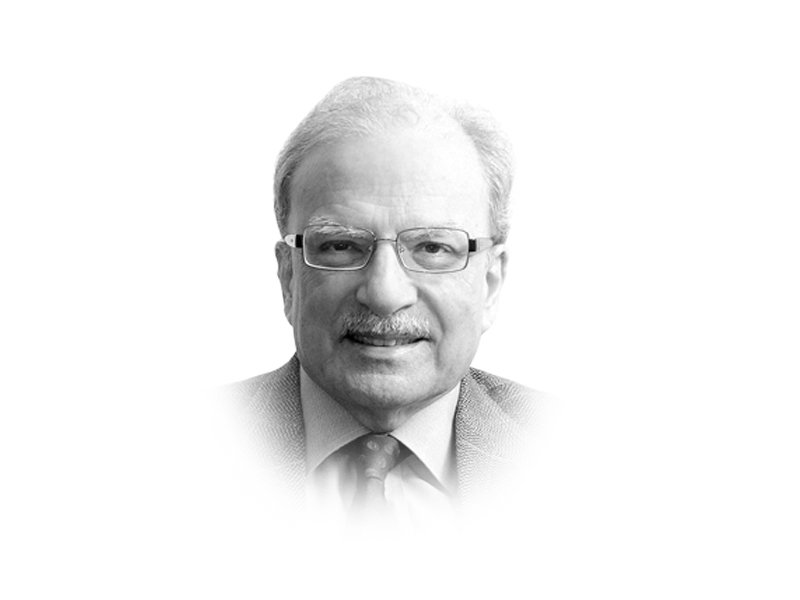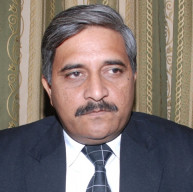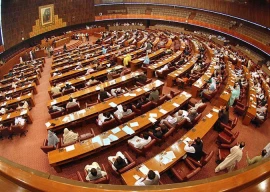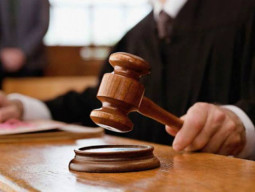
A year into its tenure, the government under the control of Prime Minister Nawaz Sharif is struggling to develop its response to the rise of extremism. Unlike the administration it succeeded, the new administration that came to office seemed committed to dealing with the scourge of extremism. It had identified it as one the three ‘Es’ that were to receive its immediate attention. The other two were energy and the economy. However, its actions since assuming power give the impression that it is lost; the terrorists have understood this and have gone ahead and escalated their assault on the institutions of the state.
In order to develop a comprehensive approach towards extremism, it is important to understand the motivating factors behind it. The rise of this phenomenon in Pakistan is taking several different forms, each one of which has a different history. The first of the identifiable forms is related to the activities of the Taliban operating from both sides of the Pakistan-Afghan border. Although the Taliban in Pakistan and Afghanistan have different organisational structures and are following different agendas in the countries in which they are operating, there is some coordination between the two groups. The two countries need to work together to curb the rising power of these groups.
The second contributing factor is sectarianism. Orthodox and conservative groups, influenced heavily by Saudi Arabia, are especially intolerant of all points of views different from those they follow. Minorities have been targeted, including the Ahmadiyya community as well as Christians. Furthermore, even Muslims have not been spared with Shias bearing the brunt of extremist attacks.
The third form of extremism is different from the first two: its focus is spatial rather than ideological. It has grown roots in Karachi and is the consequence of the way that the city has grown and developed. A number of factors have come together to make Karachi one of the world’s most violent places. First there were ethnic rivalries particularly those involving the muhajirs. The muhajir community has been fighting hard to create economic and political space for itself. To this ethnic brew was added another one: the Pashtuns. Numbering perhaps as many as five million, this group arrived in several waves. First to come were the construction workers who went to the city to build Pakistan’s first capital and lay the ground for the country’s rapid industrialisation. The second Pashtun wave came during the 10-year war with the Soviet Union’s occupation forces. This was followed by another wave as the conflict with the Pakistani state displaced hundreds of thousands of people from the northern parts of Pakistan.
Over time, Karachi, a mega city of an estimated 20 million people, has become the favoured space for the practice of these three forms of extremism. Ethnic rivalries, sectarianism and extremism have created an explosive situation in the city. The state has not developed the institutions that can mediate between these groups. The use of violence has become the preferred form of political expression.
It is important to note that these three sources of extremism affect Pakistan’s relations with the world in different ways. Of immediate consequence is the developing situation in Afghanistan and its likely impact on Pakistan. Extremism in one country feeds that in the other.
Similarly, sectarianism will most likely draw Pakistan into the developing Sunni-Shiite conflict in the Middle East. Saudi Arabia and Iran, two important state players in this region, have positioned themselves at the opposite ends of this conflict. Pakistan is attempting to maintain a balance of sorts between these two conflicting interests. Continuing troubles in Karachi will further diminish the global role this well-positioned city could have played. And, targeting girls and women and attempting to keep them backward will earn the country opprobrium from the development community. There is, therefore, the need to understand extremism and its consequences from several different angles. Focusing on one will not serve the purpose.
Published in The Express Tribune, June 16th, 2014.
Like Opinion & Editorial on Facebook, follow @ETOpEd on Twitter to receive all updates on all our daily pieces.
COMMENTS (12)
Comments are moderated and generally will be posted if they are on-topic and not abusive.
For more information, please see our Comments FAQ

































































@Arifq: Subcontinent was divided on that basis that congress/nehru wanted a secular state. Even after partition Indian Muslims have been against constitution and secularism and nowadays against democracy. Secularism in india has confined to preamble and constitution. Forget about accepting human rights, most of the Muslims don't want to discuss it. Muslims always take their religion on public spheres.
That is the doubt now - whether the Army and Government play one more double game in dealing with Good Taliban and Bad Taliban. Or their proxy agencies like LET, LEJ, JUD will be allowed to fill up the vacuum. The souls of dead soldiers will haunt the nation if this happen.
@Arifq:
"Solution is very simple, religion must be a personal issue and state declared free of religious biases"
That is an impossibility in an Islamic state. Can you ever imagine removing any and all reference to Islam in the Pakistani constitution and declaring that Islam is not the state religion?
As the wise saying goes "you can't choose to ride the tiger and then want to get off without being eaten alive". Another modified piece of wisdom would be "you can't keep the cake and not want to eat it?.
we got nothing to do with Fatimah Jinnah or ayub khan but MQM does with mian pervaz mushref regime what u think fus????
@ Ali Tanoli- You lack knowledge or love to ignore the true facts. Most of the pashtoon are peace loving but not all and it is those pashtoons who have caused the problem. If Muhajir were really against any ethnicity then the would not have been on the receiving end. Condition of country and city were lot better until things were under educated migrants and then thanks to Ayub khan who started pashtoonization of jobs and followed by Bhutoo who had to please his Sindhi waderas. Find out who started Qasbah and aligarh massacre, it was pashtoons who killed innocent people in great number, all because govt. headed by a pashtoon governor during zia's time started operation against Afghan drug and gun dealer in Sohrab Goth, these brainwashed pashtoons not only killed urdu speakers to stop govt. operation but also some pashtoon who tried to save their urdu speaking neighbors. Then who can forget what gohar Ayub did after Ayub khan defeated Fatima Jinnah election. So come out of this hatred since migrants actually lost a lot for this nation and worked to build it. What have you done other than spread hatred and took advantage of quota and baradari system that prevails to crush someone who has opportunity on merit? You have inferiority complex. Problem with Karachi is that its heart is too big, it will give space to people like you without asking anything in return, but you would misuse it and destroy it. There is no other city in whole Pakistan that comes close to the diversity of Karachi, even with all the bloodshed and problems you will find people of all ethnicity and sects leaving together as karachite. let these people of karachi have control on their city and lives and they will feed the whole country, ironically which they still do. If Karachi has 20+ million population then it means over 15% of seats in National and more than 50% in Sindh assembly should come from karachi, The problem is people like you have know knowledge of karachi issues but try to act like asi fyou know it all. Get the facts first, and then learn accept the truth. The sons of Soil has destroyed this great country.
The author came close but missed few points. Pak Army as an institution has an opportunity to shine if it plays its card right. Pakistan should ask question whats happening in other Muslim world and can it happen here and if yes how can we prevent it and who is best equipped to do the job and what tools do they need? Scenario: Can 300 girls be kidnapped in Pakistan like what happened in Nigeria? If the answer is yes than can some one identify the potential target school and take preemptive action to prevent it. Can extremist take over Pak Parliament and other institutions? Is time is right for Pakistan Army to accept its limitations and contact Army Chiefs and Policing Institutions of other nations including India and Afghanistan for help?
I doubt that it is going to happen. In the budgetary deficit days lure of 1.5 billion is too much resist.
@Burki sahib, No matter who was in power Urdu speakers allways ruled the Karachi all the jobs and busnisses in the city is accupied by muhajirs and they still cries we sarhadis people don't bother them but they have problem even they made a list of pukhtoon areas like hindu brothers does in india with muslim areas.....
The state machinery was often used to divide the people, as Zia propped up MQM as a counter force for the Sindhi(PPP) led MRD movement in 1983
"Similarly, sectarianism will most likely draw Pakistan into the developing Sunni-Shiite conflict in the Middle East." What are you telling Sir ? Pakistanis are already fighting in Syria and being recruited from many cities in Pakistan. Flames of Middle East war are bound to engulf Pakistan. Muslim world is heading towards an all out civil war. Iran is joining hands with US to fight Sunni extremists in Iraq. Latest happening in Iraq are going to put Muslim world in flames. Time of analysis is long past. Its time to act and rather take sides. Most paradoxical is that US will be supporting Sunnis in Syria and Shias in Iraq.
Simple Solution : declare yourself Secular, update the constitution. Try anone that thinks otherwise...
Solution is very simple, religion must be a personal issue and state declared free of religious biases. Next, all political parties patronizing religious extremists both locally and foreign must be made accountable in court of law and wrath of the people.